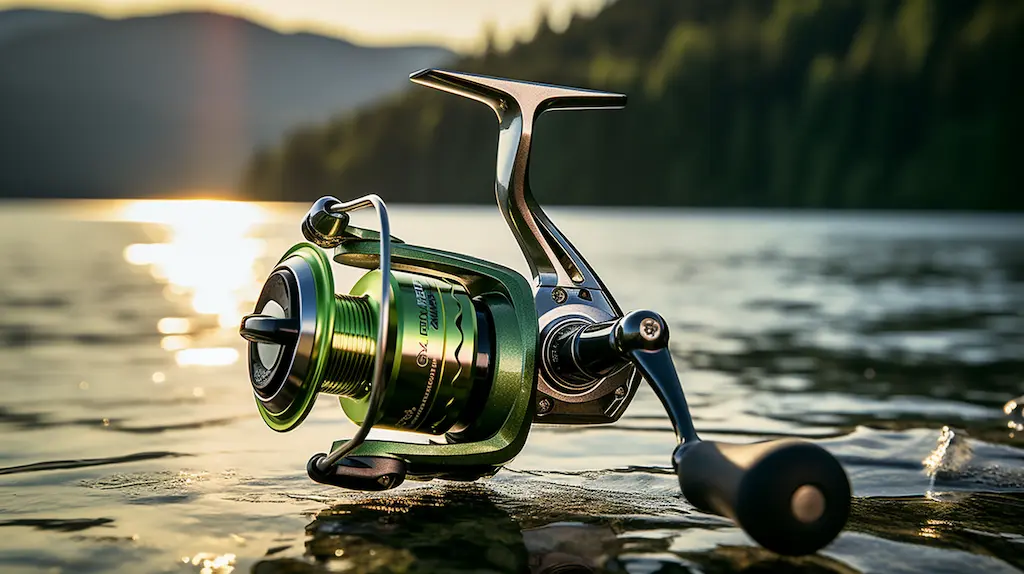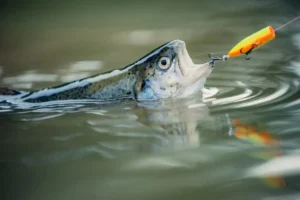Spinning vs. Casting: The Ultimate Guide to Understanding and Mastering Freshwater Fishing Techniques

If you’re diving into the world of freshwater fishing and torn between spinning and casting, it’s essential to understand that your choice can greatly influence your fishing adventures.
This article will thoroughly examine both techniques, weighing their strengths and weaknesses in different fishing scenarios. Are you prepared to uncover which method aligns perfectly with your fishing style?

Key Takeaways
- Spinning is a popular freshwater fishing technique that utilizes a fixed spool reel mounted beneath the rod. This setup is known for its ease of use and a lower likelihood of line entanglement.
- Casting, on the other hand, is a technique that provides more targeted and precise casting, characterized by a reel positioned on top of the rod. It’s particularly effective for lure fishing and heavy-duty fishing scenarios.
- The choice between spinning and casting hinges on the angler’s preference for line control during casting. Casting offers greater accuracy but demands more skill and practice.
- The advantages and disadvantages of spinning and casting vary with the type of fishing technique employed, such as bottom fishing, vertical fishing, linear scraping techniques, rapid and strong fishing, long-distance casting, light fishing, and float tube fishing.
Understanding Spinning

Spinning involves a style of fishing that utilizes a particular type of reel known as the fixed spool reel. Positioned below the fishing rod, these reels allow the line to wrap around the spool with the help of a rotating bail.
These reels are typically easier to handle and have a reduced chance of line tangling, making them an excellent choice for beginners or those seeking a straightforward and efficient fishing method.
Beyond their user-friendliness, spinning reels are remarkably versatile. They can be effectively used in various freshwater fishing situations, ranging from light to heavy fishing.
Selecting a spinning setup depends on multiple factors, including the angler’s hand size and specific fishing conditions. For instance, a spinning setup is particularly well-suited for certain types of lure fishing, like scraping methods.
Understanding Casting

Casting, a fishing style increasingly popular in Europe, is known for its more precise and straightforward casting technique compared to spinning. In casting, the reel is mounted on top of the fishing rod, unlike in spinning where it’s fixed below the rod.
This configuration allows for improved control over the line during casting, enhancing precision. Casting shines in lure fishing, as it enables anglers to target specific water zones with high accuracy.
Also, it’s well-suited for heavy and long-range fishing. The core concept of casting involves using the lure or bait’s weight to extend the casting distance, offering a significant advantage for longer casts.
With advancements in technology, casting reels have evolved, becoming more user-friendly and increasingly popular among fishermen.
Making the Right Choice: Spinning vs. Casting Techniques
When you’re faced with the decision between spinning and casting, it’s important to focus on how well you can control the line during the cast. Let’s delve into the strengths and weaknesses of each method to guide your decision.
Controlling the Line in Casting
One of the key factors in choosing between spinning and casting is how you manage the line during the cast. With casting gear, anglers gain full control over the line as soon as they release the clutch button. This technique requires practice to perfect, but it offers superior accuracy in placing the lure. In contrast, spinning is more user-friendly, involving simply holding the line with the index finger before casting. However, it may not provide the same level of precision as casting. Your choice should reflect your comfort and skill level in managing the line during a cast.
Pros and Cons in Different Fishing Conditions
Different fishing conditions influence the strengths and weaknesses of spinning and casting.
Support and Vertical Fishing Techniques
In freshwater fishing, support and vertical fishing are two prevalent techniques. Support fishing is about precision in placing your lure and letting it descend naturally, ideal for targeting bottom fish like perch and pike. Vertical fishing, on the other hand, involves casting your lure straight down from your boat or near underwater structures, then jigging it up slowly – a method effective for deep-water species.
For both techniques, it’s crucial to tailor your gear and bait to the species you’re targeting.
Linear “Scratching” Fishing
In linear “scratching” fishing, your choice between spinning and casting makes a significant difference. This technique requires continuous lure movement, making it “scratch” against underwater features like rocks or branches. Spinning rods allow for easy control of lure speed and movement, vital for this method. The spinning reel enables quick adjustments to line tension when encountering obstacles, providing enhanced control and accuracy.
Conversely, a casting setup is also viable. The main distinction lies in line control during casting. With a casting reel, you can fine-tune your cast distance using the brake system and precisely target your lure’s landing spot, especially useful when fishing near obstacles.
Rapid Fishing
In rapid fishing, whether you choose spinning or casting depends on various factors. If you prefer stronger and more precise casts, casting might be the way to go. Casting reels handle heavier lures well and enable quicker retrievals. If you value lightness and ease, spinning could be better. Spinning reels offer versatility and are ideal for lighter lures. Choose a setup that aligns with your needs in rapid fishing scenarios.
Strong Fishing
For heavy-duty fishing and targeting larger fish, selecting between spinning and casting is critical. Spinning is great for trolling or using large lures that require quick, repetitive action. It provides smoother retrieval and better resistance to tension. Casting, however, delivers more power in casting and higher line capacity, preferred for deep-water fishing or catching bigger, more aggressive fish. Consider the strength required for your fishing style to decide between spinning and casting, enhancing your chances of success.
Long-Distance Fishing
For long-distance fishing, casting generally trumps spinning. Casting rods offer more power, enabling longer casts. Casting reels have better line capacity and a more precise braking system, suited for handling long-distance fights with fish. For reaching far-off fishing spots, casting is the preferred choice.
Light Fishing
Light fishing, a popular freshwater method, uses small lures and thin lines for smaller, more delicate fish. This approach is ideal for tranquil waters like lakes and ponds where fish are easily spooked. The equipment’s lightness allows for discreet and accurate casting, improving your catch rate.
Whether you opt for a spinning or casting rod for light fishing, ensure your setup is appropriate, with a thin line and suitable lures.

Float Tube Fishing
In float tube fishing, the decision between spinning and casting is crucial. This technique, executed from a float tube, requires a unique approach. The stealth offered by a float tube allows for a quiet approach to the fish.
Spinning is often preferred for its precision and control in casting. However, some anglers lean towards casting for its longer and more powerful casts. Ultimately, the choice depends on your personal preference and the specific conditions of the fishing area.
Choosing between a Spinning or Casting reel is a crucial decision for anglers. Understanding the technical differences and weighing the pros and cons of each type is essential for optimal performance in various fishing scenarios.
Technical Differences
Spinning and casting setups exhibit distinct technical characteristics, influencing fishing style and success :
- Spinning Reels: Mounted beneath the rod, ideal for finesse fishing techniques common in European freshwater and sea angling. They are user-friendly, making them a top choice for beginners or those targeting smaller species.
- Casting Reels: Positioned on top of the rod, they are preferred for targeting larger freshwater species like pike and carp. Their design allows for more precise casting, essential for lure placement in challenging spots.
- To cast with a spinning reel, you pull the line off the reel with your free finger. With a casting reel, you use your thumb to control the line during the cast.
- Spinning rods are generally lighter and more flexible, making them ideal for lighter lures and smaller fish. Casting rods are stiffer and offer better precision for heavier lures and bigger fish.
- Spinning reels allow longer casts and easier control of distance. Casting reels offer better precision for targeting specific areas.
Advantages and Disadvantages of Spinning Reels
Anglers prefer spinning reels for their versatility and ease of use:
- Pros:
- Easy to master, suitable for all skill levels.
- Versatile for various lure weights, accommodating the diverse range of European fishing styles.
- Cost-effective, an advantage for hobbyists and those on a budget.
- Ideal for light tackle fishing, common in rivers and coastal areas.
- Cons:
- Limited casting precision compared to casting reels.
- Prone to line tangling if not managed properly.
- Potentially shorter lifespan under constant heavy use.
- Not the best choice for long-distance casting or targeting larger, stronger fish.
Advantages and Disadvantages of Casting Reels
Casting reels are gaining traction among anglers, particularly for their efficiency in specific fishing situations:
- Pros:
- Superior for long-distance casting, a bonus in large lakes and rivers.
- Better suited for heavy fishing, aligning with the increasing popularity of targeting larger species in Europe.
- Enhanced precision, crucial for lure fishing in dense vegetation or structured environments.
- Cons:
- Steeper learning curve, potentially challenging for beginners.
- Generally more expensive, which might be a consideration for casual anglers.
- Ergonomically challenging for anglers with smaller hands.
Conclusion
Anglers should base their choice of reel on personal preferences, targeted species, and the specific fishing environments they encounter. While spinning reels offer ease and versatility, ideal for diverse fishing landscape, casting reels provide precision and power for more specialized situations. As the European fishing scene evolves, understanding these nuances becomes increasingly vital. Visiting local tackle shops for tailored advice is highly recommended to ensure the best gear selection.






